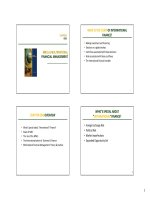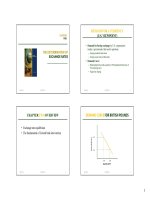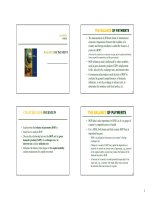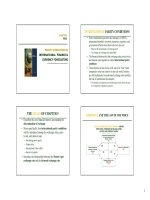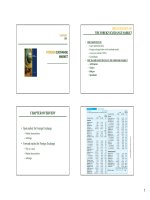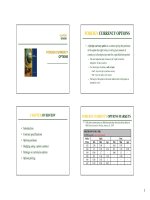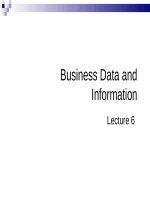Lecture multinational financial management chapter 6 ngo thi ngoc huyen
Bạn đang xem bản rút gọn của tài liệu. Xem và tải ngay bản đầy đủ của tài liệu tại đây (815.35 KB, 9 trang )
CHAPTER
SIX
FOREIGN EXCHANGE
MARKET
ORGANIZATION OF
THE FOREIGN EXCHANGE MARKET
• THE PARTICIPANTS
– Large commercial Bank
– Foreign exchange brokers in the interbank market
– Commercial customer: MNCs
– Central Banks
• THE MAJOR PARTICIPANTS IN THE FORWARD MARKET
– Arbitrageurs.
– Traders
– Hedgers
– Speculators
1
3
2
4
CHAPTER OVERVIEW
• Spot market for Foreign Exchange
Copyright@McGrawHill Educations
– Market characteristics
– Arbitrage
• Forward market for Foreign Exchange
– Why is it used
– Market characteristics
– Arbitrage
1
Copyright@McGrawHill Educations
Copyright@McGrawHill Educations
7
5
Copyright@McGrawHill Educations
6
Copyright@McGrawHill Educations
8
2
Transactions in the Interbank Market
• In interbank markets, forward exchange rates are
usually quoted for value dates of 1, 2, 3, 6, and 12
months
• Buying FX forward and selling FX forward
describe the same transaction (the only difference is
the order in which currencies are referenced)
– A FX forward contract to deliver dollars for Euros in six
months is buying Euros forward with dollars or selling
dollars forward for Euros
/>9
Exhibit 6.1 Measuring Foreign Exchange Market Activity: The
Trading Volume of Currency Transactions Per Hour
TRANSACTIONS IN THE INTERBANK MARKET
• A foreign exchange swap transaction (FX swap) in
the interbank market is the simultaneous purchase and
sale of a given amount of foreign exchange for two
different value dates with the same counterparty
• Some different types of FX swaps are:
– Spot against forward
• The dealer buys a currency in the spot market and
simultaneously sells the same amount back to the same bank in
the forward market
※This exhibit illustrates the trading volume of currency transactions ebbs and
flows as the major currency trading centers across the globe open and close
throughout the day
※The per-hour trading volume data suggests that Europe is the major center for
foreign exchange transactions, the U.S. is the next, and Asia is the third
3
TRANSACTIONS IN THE INTERBANK MARKET
• For example, if a Taiwanese firm needs US$1 million for the
following 3 months, it can enter into a spot against forward swap,
in which this firm buys US$ 1 million at the spot exchange rate
today (e.g., NT$34/US$) from a bank, and this firm agrees to sell
US$ 1 million back to the bank after three months at the 3-month
forward exchange rate (e.g., NT$32/US$)
• Because these two transactions are in a single contract with one
counterparty, it can save some transaction costs
• A swap can be viewed as a technique for borrowing another
currency on a fully collateralized basis (in the above example, the
NT$ is the cash collateral for borrowing US$ 1 million)
– Forward-forward
• For example, a dealer sells £1,000,000 forward for US dollars
for delivery in two months at $1.842/£ (two-month forward
exchange rate) and simultaneously buys £1,000,000 forward for
delivery in three months at $1.84/£ (three-month forward
exchange rate)
Transactions in the Interbank Market
• In addition to traditional spot, forward, or swap foreign
exchange transactions, there are new types of
transactions, e.g., nondeliverable forwards
• Nondeliverable forwards (NDF)
– Created in the early 1990s, NDF is now a relatively common
derivative in the interbank market
– Similar to traditional FX forward contracts, except that they
are cash-settled (in domestic currency) and the foreign
currency being sold forward or bought forward is not
delivered physically on the maturity date
– The profit or loss of the NDF at the time of the maturity date
is calculated by taking the difference between the agreed
forward exchange rate and the spot exchange rate at that time
point, for an agreed notional amount of funds
TRANSACTIONS IN THE INTERBANK MARKET
– For example, consider a NDF of buying US$1,000,000 with NT$
after one month and the one-month forward exchange rate is
NT$34/US$. After one month, if the spot exchange rate becomes
NT$35/US$, the holder of the NDF can earn (NT$35/US$ –
NT$34/US$) × US$1,000,000 = NT$1,000,000
– Note that it is not necessary to buy foreign currency
(US$1,000,000) with the domestic currency (NT$34,000,000) after
one month
• Comparing to the traditional forward contracts, on the maturity date,
the holder should buy US$1,000,000 with NT$34,000,000 physically
and resale US$1,000,000 in the market to exchange for
NT$35,000,000
– Another advantage of using NDFs is for emerging market
currencies–currencies that typically do not have liquid money
markets, because it is not necessary to buy or sell the foreign
currency physically
FOREIGN EXCHANGE MARKET CONDITION
• Every three years, the Bank for International
Settlements (BIS) conducts a survey to estimate the
global trading activity of traditional foreign exchange
transactions
• The BIS data for surveys from 1989 to 2010 is shown
in Exhibits 6.2.
• For the market size in Exhibit 6.2
– In the surveys of 2007 and 2010, the daily global trading
amount in traditional foreign exchange market activities are
$3.32 trillion and $3.98 trillion, respectively
– Those results imply increase of nearly 19.8% for the foreign
exchange trading from 2007 to 2010.
4
Exhibit 6.2 Global FX Market Turnover (daily averages in April, billions of US$)
LOCATIONAL ARBITRAGE PROFIT
CASE 1: ARBITRAGE POSSIBLE
CASE 2: NO ARBITRAGE POSSIBLE
• New York Bank quotes:
• Chicago Bank quotes:
– Ask $1.84/1BP
– Ask $0.64/1SF
– Bid $1.81/1BP
– Bid $0.60/1SF
• London Bank quotes:
• Berlin Bank quotes:
– Ask $1.89/1BP
– Ask $0.66/1SF
– Bid $1.86/1BP
– Bid $0.62/1SF
Generally speaking, all three categories of traditional currency transactions have rising trends from 1989 to 2010
/>
LOCATIONAL ARBITRAGE
19
THE SPOT MARKET
CURRENCY ARBITRAGE
• Buy low in one location & sell high in another location
– For example, suppose we observed the following for the
Mexican peso (Ps) and the Swiss franc (SF):
In the FX market
– The buying price (ask price) in one bank is lower than the selling
price (bid price) of another bank
Ps per $1 = 10.00 in Mexico
SF per $1 = 2.00 in New York
Ps per SF1= 4.00 in Zurich
• Market adjustments which will eliminate locational
arbitrage
– Is there an arbitrage opportunity, suppose you have $100?
In the FX market:
– The ask price will rise and bid price will fall
– Till ask price (of one bank) is greater than or equal to bid price (of
another bank)
18
20
5
FOREIGN EXCHANGE MANAGEMENT - IRP
CURRENCY ARBITRAGE
4. Round-trip profit equals $25
New York
Example: US corporation receive dividend from France Subsidiary
Company. They decide to invest this money to another company in
Start
$100
Finish
$125
3. Buy dollars
in NY at
SF2/$
Swiss. Whether they buy SFr, as follow information:
1. Sell $100 in
Mexico at
Multiplied
Ps10/$
Ps10/$
Divided by
SF2/$
Citibank:
$1.4341-1.4372/€
Eurobank
SF 250
Zurich
€0.6777-97/$
€0.6218-58/SFr
Ps 1.000
Divided by
Ps4/SF
$0.9050-0.9071/SFr
Mexico
UBS
SFr1.1024-53/$
SFr1.6010-40/€
2. Buy these SFr in Zurich at
Ps4/SF
21
THE SPOT MARKET
CURRENCY ARBITRAGE
23
USING FORWARD CONTRACTS FOR
SPECULATION: THEORY
• Buy Forward Contracts (take a Long Position in the FM):
– Example, suppose the exchange rate for the British pound
and Swiss Franc
When you expect the future spot rate to be higher then the current forward rate:
– You will gain when the future spot rate is higher than the current forward exchange
rate
– You will lose when the future spot rate is lower than the current forward exchange
rate
– Pound per $1 in New York = 0.6
– SF per $1 in Frankfurt
= 2.00
– SF per pound in London
= 3.00
• Sell Forward Contracts (take a Short Position in the FM):
When you expect the future spot rate to be lower then the current forward rate:
– You will gain when the future spot rate is lower than the current forward exchange
rate
– You will lose when the future spot rate is higher than the current forward exchange
rate
– Is there an arbitrage opportunity, assume you have $100?
22
24
6
INTEREST RATE PARITY THEORY
INTEREST RATE PARITY - IRP
• Spot and forward rate are closely linked to each other and to interest in
different currencies through the medium of arbitrage.
• The movement funds between two currencies to take advantage of
interest rate differential is a major determinant of the spread between
forward rate and spot rates.
• The forward discount and premium is closely related to the interest
differential between the two currencies.
• According to interest parity theory, the currency of the country with a
lower interest rate should be at a forward premium in terms of the
country with higher rate
• In the efficient market with no transaction cost, the interest
differential should be equal to forward differential
• Covered interest arbitrage forces interest rates on different currencies to
be at parity with each other.
Indicate:
f: forward rate compute from interest rate parity equation,
F: forward rate in the market
If F > f : sell foreign currency in forward rate
If F < f : buy foreign currency in forward rate
f s
(1 rh )
(1 rf )
25
27
INTEREST RATE PARITY - IRP
Fund will flow from home country to foreign country if and only if:
(1 rh )
•
Illustration,
• Suppose an investor with $1.000.000 to invest for 90 days.
Interest rate and exchange rate in exchange market as follows:
– 8%per annum (2%/90 days)in dollar, 6%/year (1.5%/90 days)
in SFr
– Spot rate: SFr1.5311/$, 90-day forward rate: SFr 1.5146/$
1 rh
F S
1 rf
1 rh F
1 rf
S
•
INTEREST RATE PARITY - IRP
F
(1 r f )
S
Fund will flow from foreign country to home country if and only if:
(1 rh )
F
(1 r f )
S
26
28
7
INTEREST RATE PARITY - IRP
INTEREST RATE PARITY - IRP
Illustration,
• Suppose an investor with $1.000.000 to invest for 90 days.
Interest rate and exchange rate in exchange market as follows:
– 8%per annum (2%/90 days)in dollar, 6%/year (1.5%/90 days)
in SFr
– Spot rate: SFr1.5311/$, 90-day forward rate: SFr 1.5236/$
• When transaction cost exist, how can define arbitrage opportunity.
• Defined:
– Sb & Sa : Bid price and ask price (spot rate)
– Fb & Fa : Bid price and ask price (Forward rate)
– rha & rhb : borrow rate (ask rate) and lend rate (bid rate) in home currency
– rfa & rfb : borrow rate and lend rate (foreign currency)
There are two cases:
– borrow in home currency
– Borrow in foreign currency
29
INTEREST RATE PARITY - IRP
31
INTEREST RATE PARITY - IRP
• Borrow in home currency
• Example:
• Suppose: 7%/year for dollar in New York, 12%/year for £
in London - Spot rate: £ =$1.75, one year forward rate : £
=$1.68
• Is there an arbitrage opportunity? Compute the profit
using $?
Fb S a
1 iha
1 i
fa
fb
• Fb> fa: company can gain in the foreign exchange, by selling foreign
currency at forward rate
• Borrow in foreign currency
Fa S b
1 ihb
1 i
fb
fa
• Fa fb: company can gain in the foreign exchange, by buying foreign
currency at forward rate
30
32
8
INTEREST RATE PARITY - IRP
INTEREST RATE PARITY - IRP
• Suppose the annualized interest rate on 180-day GBP
deposits is 67/16-5/16%, meaning that GBP can borrowed at
67/16% (ask rate) and lent at 65/16% (bid rate). At the same
time, the annualized interest rate on 180-day AUD deposits
is 9 3/8-1/8%, spot rate and 180 day forward quotes on AUD
are £0.4706-80/AU$ and £0.4811-75/AU$ respectively. Is
there an arbitrage opportunity? Compute the profit.
•
•
Covered cost and arbitrage opportunity
American company will pay €100.000 due in 180 days. They can one of two
ways as follows:
– Negotiating 180 day forward contract
– Investing in money market, borrow USD ---> convert to Euro ---> invest
Euro at r can get € 100.000 in 180 days.
– Compare 2 technical term and make a decision
EX.: American company have to pay € 100,000 to German company due in
180 days. Company want to expose this payment. Suppose, Spot rate:
$1.14/ €, and 180 day-Forward rate: $1.24/€. Interest in European money
market: 8%/year for $ and 10%/year for €.
33
INTEREST RATE PARITY - IRP
35
IMPACT OF ARBITRAGE ON AN MNC’S VALUE
• Suppose the annualized interest rate on EUR deposits is 77.5%, meaning that EUR can borrowed at 7.5% (ask rate)
and lent at 7% (bid rate). At the same time, the annualized
interest rate on USD deposits is 91/4-3/4%, spot rate and one
year forward rate quotes on EUR are 1.2320-60$/€ and
1.2430-80$/€ respectively. Is there an arbitrage
opportunity? Compute the profit.
34
Forces of Arbitrage
m
E CFj , t E ER j , t
n
Value = j 1
t
1 k
t =1
E (CFj,t ) = expected cash flows in currency j to be received
by the U.S. parent at the end of period t
E (ERj,t ) = expected exchange rate at which currency j can
be converted to dollars at the end of period t
k
= weighted average cost of capital of the parent 36
9

